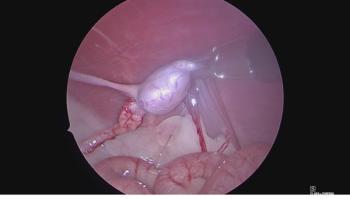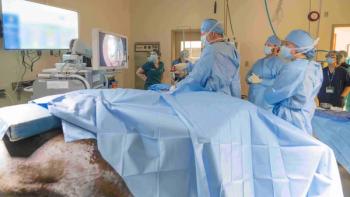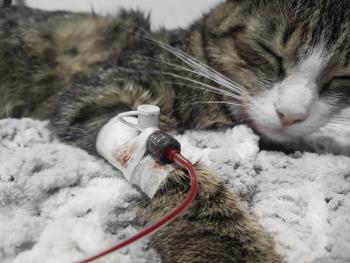
Respiratory emergencies: surgical intervention for respiratory distress (Proceedings)
A number of respiratory emergencies may ultimately require surgical intervention, but the surgical techniques most likely to be indicated on an emergent basis are tube tracheostomy, tracheal resection/anastomosis, tube thoracostomy, and diaphragmatic hernia repair.
A number of respiratory emergencies may ultimately require surgical intervention, but the surgical techniques most likely to be indicated on an emergent basis are tube tracheostomy, tracheal resection/anastomosis, tube thoracostomy, and diaphragmatic hernia repair.
Tube Tracheostomy
Temporary tracheostomy tube placement is performed to bypass upper airway obstructions. The emergent "slash" tracheostomy should be a rare occurrence; usually, there is time to capture the airway with an endotracheal tube and prepare the patient for a controlled surgical approach. Make a ventral midline cervical skin incision just caudal to the larynx for a distance of approximately 4 cm. Separate the sternohyoideus muscles on the midline and incise the interannular ligament between the second and third tracheal rings. This tracheal location is chosen because it is the preferred stomal site for permanent tracheostomy should such be required. Place stay sutures around the second and third tracheal rings, knot the sutures and tag them with hemostats. Use the stay sutures to manipulate the interannular opening while the endotracheal tube is removed and the tracheostomy tube is inserted. [During the postoperative course, the stay sutures can be used for manipulation during re-insertion of a tube that has been inadvertently dislodged or requires changing.] An uncuffed tracheostomy tube (or cuffed tube with the cuff deflated) is used if the objective is merely to bypass an obstruction, whereas a cuffed tube is used if positive pressure ventilation or anesthesia is to be employed. Secure the tracheostomy tube by attaching umbilical tape to the wings and tying the tapes behind the neck. Permanent tracheostomy, a salvage technique for untreatable upper airway obstruction, could be done in lieu of temporary tube tracheostomy; however, on an emergency basis it is rare to determine that the only treatment possibility is to create a permanent tracheal stoma.
Tracheal Resection And Anastomosis
Tracheal resection is indicated when an isolated segment of trachea is irreversibly damaged or diseased. Up to 17 tracheal rings have been successfully resected in dogs. [Dogs have 34 to 44 total tracheal rings.] However, it is recommended to remove as few rings as possible to minimize tension and resultant stricture formation. A standard ventral midline cervical approach is performed when the cervical trachea is affected. The intrathoracic trachea is approached through a right third intercostal space thoracotomy.
There are three tracheal anastomosis techniques: (1) the split-cartilage technique, where the most cranial and most caudal rings are bisected such that the two halves are apposed with sutures, (2) the annular ligament-cartilage technique, where the cranial and caudal incisions are in the interannular ligaments and the cranial and caudal segments are apposed with sutures that go around the rings at the anastomotic site, and (3) the interannular technique, where the cranial and caudal incisions are in the interannular ligaments and the cranial and caudal segments are apposed with sutures that incorporate only the interannular ligaments at the anastomotic site. Of these 3 techniques, the split-cartilage technique is preferred because it has been shown to result in the least amount of stenosis and luminal attenuation. Synthetic absorbable (or nonabsorbable) monofilament sutures are preferred for the anastomosis. When a large segment of trachea is excised 2 or 3 tension-relieving sutures are placed to support the primary repair. These sutures are placed from a tracheal ring 2 to 3 rings caudal to the anastomosis to a tracheal ring 2 to 3 rings cranial to the anastomosis and tied such that tension on the primary anastomotic suture line is minimized.
Thoracostomy Tube Placement
Thoracocentesis is used for emergent treatment of pneumothorax and pleural effusions; percutaneous thoracostomy tube placement is required when pneumothorax or pleural effusion persists. Percutaneous thoracostomy tube placement is performed with the animal anesthetized and intubated. Commercially available trochar-type tubes are used to facilitate entry through the intercostal muscles after tunnelling from the skin incision under the latissimus dorsi muscle to the intercostal entry point. The tube diameter should be approximately the same diameter as that of the animal's mainstem bronchus or small enough to fit comfortably between two ribs. Typically, the skin incision is a small stab just large enough to accommodate the tube and placed in the dorsal third of the thoracic wall over the ninth or tenth rib. Make a stab incision that penetrates the skin and the underlying latissimus dorsi muscle. Then, advance the tube beneath the latissimus dorsi muscle, and tunnel in a cranioventral direction to the seventh or eighth intercostal space. Raise the tube so that it is perpendicular to the intercostal space in preparation for a controlled thrust through the intercostal muscles. If excessive force is applied to the trochar inadvertent intrathoracic injury may occur. After elevating the tube so that it is perpendicular to the thoracic wall, grip the tube close to the chest wall with the nondominant hand, leaving a space between the hand and chest wall that approximates the thickness of the chest wall. Then, carefully but briskly thrust the tube into the thoracic cavity by tapping the trochar with the dominant hand. Retract the trochar for a cm and advance the tube toward the sternum. When the sternum is reached, remove the trochar and advance the tube a bit further. The objective is to have the fenestrated portion of the tube just dorsal to the sternum and the tip of the tube approaching (but not through) the thoracic inlet. After evaculating pleural air, take a radiograph to confirm tube placement, and anchor the tube to skin and underlying muscle fascia with friction sutures. A mattress suture may be placed in the skin incision around the tube to provide a seal and negate the need for suturing upon tube removal. Ongoing pneumothorax and pleural effusions are best managed by interfacing thoracostomy tubes with continuous suction thoracic drainage systems. Intermittent thoracostomy tube aspiration is an alternative if continuous suction is not practical, but does not allow consistent lung expansion as air or fluid accumulates between aspirations.
Diaphragmatic Hernia Repair
Diaphragmatic hernia does not necessarily require immediate surgical correction. In fact, the highest mortality rates have been reported in dogs operated upon during the first 24 hours after the inciting trauma. However, the key to timing of surgical intervention for diaphragmatic hernia lies in the stability of the patient rather than a dogmatic time frame. As such, it is recommended that diaphragmatic herniorrhaphy be performed as soon as the patient is hemodynamically stable. One exceptional circumstance that may dictate immediate surgical intervention even in the face of questionable patient stability is when the stomach is herniated into the thoracic cavity. Should the displaced stomach become dilated serious compromise to lung expansion may result and place the animal in an immediately life-threatening situation. Orogastric intubation may buy a little time in this situation, but immediate surgical intervention is undoubtedly necessary to ensure decompression and repositioning of the stomach and adequate lung expansion.
Diaphragmatic hernia is repaired via a ventral midline celiotomy. Surgical preparation should include the sternum in case surgical findings and necessary manipulations require a caudal median (or paramedian) sternotomy; however, sternotomy is rarely required. Also, care is taken to avoid rapid inflation of atelectasis to prevent re-expansion pulmonary edema. Surgical repair of the rent in the diaphragm is performed with polyproplyene suture in a continuous pattern beginning in the most inaccessible portion of the tear so that traction on the suture brings the wound edges closer to the surgeon during suturing. Before the rent is closed a thoracostomy tube is placed. The tube is introduced into the abdomen via a puncture in the abdominal wall. A purse string suture is placed in a healthy portion of the diaphragm, a stab incision is made in the center of the purse string, and the tube is passed through the diaphragmatic stab incision and properly positioned in the thorax. The purse string is tied, closure of the rent is completed, friction sutures are placed externally to prevent premature tube removal, and routine abdominal closure is performed.
Newsletter
From exam room tips to practice management insights, get trusted veterinary news delivered straight to your inbox—subscribe to dvm360.




